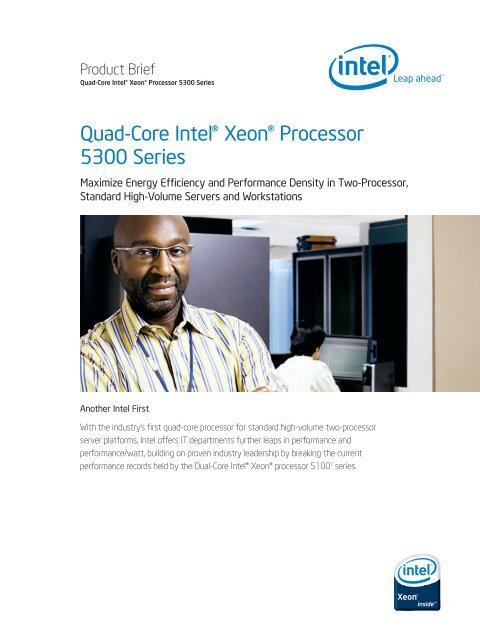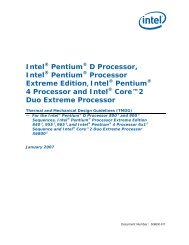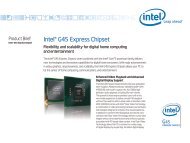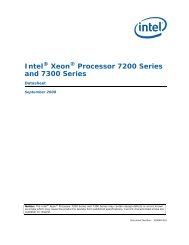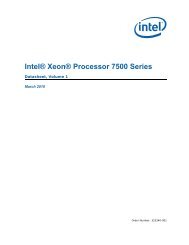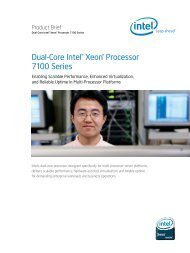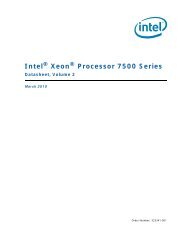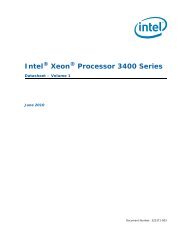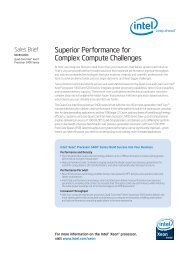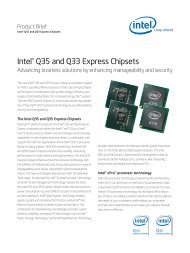Quad-Core Intel® Xeon® Processor 5300 Series
Quad-Core Intel® Xeon® Processor 5300 Series
Quad-Core Intel® Xeon® Processor 5300 Series
Create successful ePaper yourself
Turn your PDF publications into a flip-book with our unique Google optimized e-Paper software.
Product Brief<br />
<strong>Quad</strong>-<strong>Core</strong> <strong>Intel®</strong> <strong>Xeon®</strong> <strong>Processor</strong> <strong>5300</strong> <strong>Series</strong><br />
<strong>Quad</strong>-<strong>Core</strong> <strong>Intel®</strong> <strong>Xeon®</strong> <strong>Processor</strong><br />
<strong>5300</strong> <strong>Series</strong><br />
Maximize Energy Efficiency and Performance Density in Two-<strong>Processor</strong>,<br />
Standard High-Volume Servers and Workstations<br />
Another Intel First<br />
With the industry’s first quad-core processor for standard high-volume two-processor<br />
server platforms, Intel offers IT departments further leaps in performance and<br />
performance/watt, building on proven industry leadership by breaking the current<br />
performance records held by the Dual-<strong>Core</strong> <strong>Intel®</strong> <strong>Xeon®</strong> processor 51001 series.
2<br />
A More Efficient Data Center<br />
Two-processor platforms based on the <strong>Quad</strong>-<strong>Core</strong> <strong>Intel®</strong> <strong>Xeon®</strong> processor <strong>5300</strong>1 series and the <strong>Intel®</strong> <strong>Core</strong> microarchitecture help companies maximize data<br />
center performance and density, while reducing cooling challenges. Platforms<br />
based on Intel’s new quad-core technology make it easier to deliver more<br />
business services in existing facilities, or condense applications for more<br />
efficient operations at lower total cost of ownership (TCO).<br />
Two-processor platforms based on the <strong>Quad</strong>-<strong>Core</strong> Intel Xeon processor <strong>5300</strong><br />
series deliver 8-thread, 32- and 64-bit processing capabilities with 8 MB of L2<br />
cache per processor, 2 providing more computing for threaded applications in a<br />
variety of deployments. The <strong>Quad</strong>-<strong>Core</strong> Intel Xeon processor <strong>5300</strong> series is<br />
ideal for the densest of computing environments where best performance<br />
and performance per watt are key requirements. Supported by the <strong>Intel®</strong> 5000<br />
chipset family and Fully Buffered DIMM (FBDIMM) technology, <strong>Quad</strong>-<strong>Core</strong> Intel<br />
Xeon processor <strong>5300</strong> series-based platforms are expected to deliver breakthrough<br />
performance with better power efficiency, delivering up to 1.5 times<br />
the performance compared to leading Dual-<strong>Core</strong> <strong>Intel®</strong> <strong>Xeon®</strong> processor 5100<br />
series in the same power envelope and up to 2.4 times the performance<br />
compared to the best published results of AMD Opteron* Model 2222. 3<br />
Maximize performance,<br />
performance/watt, and data<br />
center density with the industry’s<br />
first quad-core technology<br />
With 4 cores, large 8 MB of on-die L2 cache, 2<br />
and the performance-enhancing and energyefficient<br />
technologies of the Intel <strong>Core</strong> microarchitecture,<br />
the <strong>Quad</strong>-<strong>Core</strong> Intel Xeon processor<br />
<strong>5300</strong> series helps IT departments maximize<br />
performance and density with fewer cooling<br />
challenges. Many server applications are wellthreaded<br />
as a result of years of running in<br />
symmetric multi-processing environments.<br />
Well-threaded server applications will benefit<br />
from more cores, larger cache, and higher<br />
throughput and memory capacity of <strong>Quad</strong>-<br />
<strong>Core</strong> Intel Xeon processor <strong>5300</strong> series-based<br />
servers and the Intel <strong>Core</strong> microarchitecture.<br />
Find out more about Intel <strong>Core</strong> microarchitecture<br />
at http://www.intel.com/technology/<br />
architecture-silicon/core/index.htm.<br />
Platforms based on the <strong>Quad</strong>-<strong>Core</strong> Intel Xeon<br />
processor <strong>5300</strong> series also support many<br />
<strong>Intel®</strong> advanced server technologies that help<br />
companies enhance operations, reduce costs,<br />
and improve business continuity:<br />
• <strong>Intel®</strong> Virtualization Technology4 (<strong>Intel®</strong> VT)<br />
provides hardware assistance to virtualization<br />
software, increasing its efficiency and<br />
enabling new capabilities including 64-bit<br />
guest OS support. The new <strong>Quad</strong>-<strong>Core</strong> Intel<br />
Xeon processor <strong>5300</strong>5 includes new Intel VT<br />
extensions to further optimize and accelerate<br />
virtualization on <strong>Intel®</strong> architecture.<br />
• <strong>Intel®</strong> I/O Acceleration Technology6 (<strong>Intel®</strong><br />
I/OAT) provides, hardware- and softwaresupported<br />
I/O acceleration that significantly<br />
improves data throughput.
Virtualize confidently with more<br />
performance headroom, enhanced<br />
reliability, and industry-wide<br />
commitment and support.<br />
<strong>Quad</strong>-<strong>Core</strong> Intel Xeon processor <strong>5300</strong> series<br />
delivers the most headroom and performance of<br />
any two-processor general-purpose server, so you<br />
can confidently consolidate applications onto fewer<br />
systems using proven industry-standard virtualization<br />
solutions. With the highest performance per watt of<br />
our <strong>Intel®</strong> <strong>Xeon®</strong> processors, you can virtualize<br />
environments onto dense 1U rack and blade form<br />
factors with fewer cooling challenges, giving you<br />
more performance and services per square foot.<br />
<strong>Quad</strong>-<strong>Core</strong> Intel Xeon processor <strong>5300</strong> series<br />
integrates virtualization hardware support with Intel<br />
Virtualization Technology, which enables more efficient<br />
virtualization solutions and greater capabilities<br />
including 64-bit guest operating system support. The<br />
new <strong>Quad</strong>-<strong>Core</strong> Intel Xeon processor <strong>5300</strong> includes<br />
new Intel VT extensions around interrupt handling<br />
that will further optimize virtualization software efficiency.<br />
5 A growing number of independent software<br />
vendors (ISV) and original equipment manufacturers<br />
(OEM) support virtualization on Intel Virtualization<br />
Technology-enabled platforms through the Intel<br />
and VMware Virtualize ASAP program, the industry’s<br />
first and only collaborative, global effort to deliver<br />
optimized virtualization solutions and practices<br />
to IT professionals and companies.<br />
The 64-bit computing of the <strong>Quad</strong>-<strong>Core</strong> Intel Xeon<br />
processor <strong>5300</strong> series gives you additional application<br />
headroom, memory flexibility, and increased security<br />
for virtual and dedicated environments. By supporting<br />
larger data sets and both 32- and 64-bit applications,<br />
Dual-<strong>Core</strong> and <strong>Quad</strong>-<strong>Core</strong> Intel Xeon processor-based<br />
servers and workstations allow the smooth migration<br />
of your business to 64-bit applications. And, with<br />
millions of 64-bit processors already shipped, you<br />
know you can depend on Intel’s proven track record<br />
to help you make a smooth transition to the next<br />
level of computing.<br />
3
<strong>Quad</strong>-<strong>Core</strong> <strong>Intel®</strong> <strong>Xeon®</strong> <strong>Processor</strong> <strong>5300</strong> <strong>Series</strong> Overview<br />
Two-processor servers and workstations based on the <strong>Quad</strong>-<strong>Core</strong> Intel Xeon processor <strong>5300</strong> series maximize<br />
performance and efficiency, with reliability, versatility, and low ownership costs.<br />
Features Benefits<br />
<strong>Quad</strong>-core processing • Maximizes performance and performance/watt for greater performance per square<br />
foot for data center infrastructures and highly dense deployments.<br />
• Increases performance and threading headroom for multi-threaded applications and<br />
heavy multi-tasking scenarios, plus helps boost system utilization through virtualization<br />
and application responsiveness.<br />
<strong>Intel®</strong> <strong>Core</strong> microarchitecture • Better performance on multiple application types and user environments, while reducing<br />
cooling challenges, enabling more capable, denser data center deployments.<br />
Large 8 MB of on-die L2 cache2 • Increases efficiency of L2 cache-to-core data transfers, maximizing main memory to<br />
processor bandwidth and reducing latency.<br />
• Up to 4 MB of L2 cache can be allocated to one core.<br />
1066 and 1333 MHz system bus • Fast, dedicated front-side buses for increased throughput.<br />
<strong>Intel®</strong> Virtualization Technology 4 • A processor hardware enhancement that assists virtualization software, enabling more<br />
efficient virtualization solutions and greater capabilities including 64-bit guest operating<br />
system support. The new <strong>Quad</strong>-<strong>Core</strong> <strong>Intel®</strong> <strong>Xeon®</strong> processor <strong>5300</strong> 1,5 includes new <strong>Intel®</strong> VT<br />
extensions around interrupt handling that will further optimize virtualization software<br />
efficiency.<br />
<strong>Intel®</strong> 64 architecture 7 • Flexibility for 64-bit and 32-bit applications and operating systems.<br />
Demand-Based Switching (DBS) with • Helps reduce average system power consumption and potentially improves<br />
Enhanced Intel SpeedStep® technology system acoustics.<br />
4<br />
Find out more about <strong>Quad</strong>-<strong>Core</strong><br />
<strong>Intel®</strong> <strong>Xeon®</strong> processors at<br />
www.intel.com/xeon
What is the 5000 Sequence?<br />
At Intel, our processor series numbers help differentiate processor features beyond front-side bus (FSB) speed<br />
and brand name. New advancements in our processors — other than bus speed — like number of cores,<br />
architecture, cache, power dissipation, and embedded Intel technologies, contribute significantly to performance,<br />
power efficiency, and other end-user benefits. Our processor sequences will help developers decide on the best<br />
processor for their platform designs, and help end-users understand all the characteristics that contribute to<br />
their overall experience.<br />
Intel offers four processor number sequences for server applications<br />
<strong>Processor</strong> Sequence 1 Used For<br />
Dual-<strong>Core</strong> and <strong>Quad</strong>-<strong>Core</strong> <strong>Intel®</strong> <strong>Xeon®</strong> processor 3000 sequence One-processor servers for small business, entry, or first server<br />
Dual-<strong>Core</strong> and <strong>Quad</strong>-<strong>Core</strong> <strong>Intel®</strong> <strong>Xeon®</strong> processor 5000 sequence Two-processor general-purpose, standard high-volume servers and workstations<br />
based on the Intel Xeon processor<br />
Dual-<strong>Core</strong> <strong>Intel®</strong> <strong>Xeon®</strong> processor 7000 sequence Greater scalability with 4- to 32-processor enterprise servers based on the Intel<br />
Xeon processor<br />
Dual-<strong>Core</strong> <strong>Intel®</strong> Itanium® 2 processor 9000 sequence Maximum performance and scalability for RISC replacement usage with<br />
2- to 512-processor servers<br />
<strong>Quad</strong>-<strong>Core</strong> Intel Xeon <strong>Processor</strong> <strong>5300</strong> <strong>Series</strong><br />
The <strong>Quad</strong>-<strong>Core</strong> Intel Xeon processor <strong>5300</strong> series is available in a range of FSB speeds and power ratings to<br />
match different computing demands. All processors integrate Intel Virtualization Technology and Intel 64<br />
architecture, and are available in the LGA771 packaging.<br />
Cache Front-Side Demand-Based<br />
<strong>Processor</strong> Number 1 Speed Size Bus Power Switching<br />
<strong>Quad</strong>-<strong>Core</strong> <strong>Intel®</strong> <strong>Xeon®</strong> processor X5365 3.00 GHz 8 MB 1333 MHz 120W Yes<br />
<strong>Quad</strong>-<strong>Core</strong> <strong>Intel®</strong> <strong>Xeon®</strong> processor X5355 2.66 GHz 8 MB 1333 MHz 120W Yes<br />
<strong>Quad</strong>-<strong>Core</strong> <strong>Intel®</strong> <strong>Xeon®</strong> processor E5345 2.33 GHz 8 MB 1333 MHz 80W Yes<br />
<strong>Quad</strong>-<strong>Core</strong> <strong>Intel®</strong> <strong>Xeon®</strong> processor E5335 2.00 GHz 8 MB 1333 MHz 80W No<br />
<strong>Quad</strong>-<strong>Core</strong> <strong>Intel®</strong> <strong>Xeon®</strong> processor E5320 1.86 GHz 8 MB 1066 MHz 80W Yes<br />
<strong>Quad</strong>-<strong>Core</strong> <strong>Intel®</strong> <strong>Xeon®</strong> processor E5310 1.60 GHz 8 MB 1066 MHz 80W No<br />
<strong>Quad</strong>-<strong>Core</strong> <strong>Intel®</strong> <strong>Xeon®</strong> processor L5335 2.00 GHz 8 MB 1333 MHz 50W No<br />
<strong>Quad</strong>-<strong>Core</strong> <strong>Intel®</strong> <strong>Xeon®</strong> processor L5320 1.86 GHz 8 MB 1066 MHz 50W No<br />
<strong>Quad</strong>-<strong>Core</strong> <strong>Intel®</strong> <strong>Xeon®</strong> processor L5310 1.60 GHz 8 MB 1066 MHz 50W No<br />
5
Maximize Performance with <strong>Quad</strong>-<strong>Core</strong> <strong>Intel®</strong> <strong>Xeon®</strong><br />
<strong>Processor</strong> <strong>5300</strong> <strong>Series</strong><br />
Get performance per watt information on the <strong>Quad</strong>-<strong>Core</strong> Intel Xeon processor <strong>5300</strong> series at<br />
www.intel.com/performance/server/xeon/ppw.htm<br />
Benchmark Description for SunGard ACR*: SunGard ACR is a financial services application. Per SunGard, “SunGard Adaptiv Credit Risk (ACR) provides a total, real-time credit risk solution for counterparty<br />
credit exposure aggregation, global limit management, credit risk analytics and collateral management.” This workload analyzes a large portfolio of client assets and generates a credit risk evaluation. The<br />
more quickly the workload completes, the more quickly the user receives the evaluation, so improving performance can improve productivity. SunGard developed the Adaptiv Credit Risk workload and supplied<br />
the computational engine and financial data.<br />
Configuration Details: Data Source: Intel internal measurement August 2007.<br />
Dual-<strong>Core</strong> <strong>Intel®</strong> <strong>Xeon®</strong> <strong>Processor</strong> 5160-based platform details: Intel Server pre-production platform with two Dual-<strong>Core</strong> <strong>Intel®</strong> <strong>Xeon®</strong> <strong>Processor</strong> 5160, 3.00 GHz with 4M L2 Cache, 1333 MHz system bus,<br />
8 GB (8x1 GB) 667 MHz FB-DIMM memory, Microsoft Windows Server 2003 Enterprise x64 Edition. SunGard Adaptiv Credit Risk 64-bit version workload.<br />
<strong>Quad</strong>-<strong>Core</strong> <strong>Intel®</strong> <strong>Xeon®</strong> <strong>Processor</strong> X5365-based platform details: Intel Server pre-production platform with two <strong>Quad</strong>-<strong>Core</strong> <strong>Intel®</strong> <strong>Xeon®</strong> <strong>Processor</strong> X5365, 3.0 GHz with 2x4M L2 Cache, 1333 MHz<br />
system bus, 8 GB (8x1 GB) 667 MHz FB-DIMM memory, Microsoft Windows Server 2003 Enterprise x64 Edition. SunGard Adaptiv Credit Risk 64-bit version workload.<br />
Benchmark Description for Linpack: Linpack is a floating-point benchmark that solves a dense system of linear equations in parallel. The metric produced is Giga-FLOPS or billions of floating-point<br />
operations per second. The benchmark is used to determine the world’s fastest computers at the website http://www.top500.org/.<br />
Configuration Details: Data Source: Intel internal measurement August 2007.<br />
Dual-<strong>Core</strong> <strong>Intel®</strong> <strong>Xeon®</strong> <strong>Processor</strong> 5160-based platform details: Intel Server pre-production platform with two Dual-<strong>Core</strong> <strong>Intel®</strong> <strong>Xeon®</strong> <strong>Processor</strong> 5160, 3.0 GHz with 4M L2 Cache, dual 1333 MHz system<br />
bus, 8 GB (8x1 GB) 667 MHz FB-DIMM memory; Red Hat Enterprise Linux AS Release 4 (Nahant update 3) Linux Kernel version 2.6.9-34.eLsmp on X86-64. 5Kx5K through 30Kx30K matrix sizes used.<br />
Intel Linpack.<br />
<strong>Quad</strong>-<strong>Core</strong> <strong>Intel®</strong> <strong>Xeon®</strong> <strong>Processor</strong> X5365-based platform details: Intel Server pre-production platform with two <strong>Quad</strong>-<strong>Core</strong> <strong>Intel®</strong> <strong>Xeon®</strong> <strong>Processor</strong> X5365, 3.0 GHz with 2x4M L2 Cache, 1333 MHz<br />
system bus, 8 GB (8x1GB) 667 MHz FB-DIMM memory, Red Hat Enterprise Linux Server 5 Linux Kernel version 2.6.18-8.el5 on x86_64. 5Kx5K through 30Kx30K matrix sizes used; Workload Type: Scalar.<br />
Intel Linpack.<br />
Benchmark Description for Application Server: This workload measures the performance of a Java Application Server in a multi-tier environment with a Database backend server and a Java Application<br />
server.<br />
Configuration Details: Data Source: Intel internal measurement August 2007.<br />
Dual-<strong>Core</strong> <strong>Intel®</strong> <strong>Xeon®</strong> <strong>Processor</strong> 5160-based platform details: Intel Server pre-production platform with two Dual-<strong>Core</strong> <strong>Intel®</strong> <strong>Xeon®</strong> <strong>Processor</strong> 5160, 3.00 GHz with 4M L2 Cache, 1333 MHz system bus,<br />
16 GB (8x2GB) 667 MHz FB-DIMM memory, RedHat* Enterprise Linux 5 OS. BEA WebLogic* Server 10.0 Application Server.<br />
<strong>Quad</strong>-<strong>Core</strong> <strong>Intel®</strong> <strong>Xeon®</strong> <strong>Processor</strong> X5365-based platform details: Intel Server pre-production platform with two <strong>Quad</strong>-<strong>Core</strong> <strong>Intel®</strong> <strong>Xeon®</strong> <strong>Processor</strong> X5365, 3.0 GHz with 2x4M L2 Cache, 1333 MHz<br />
system bus, 16 GB (8x2GB) 667 MHz FB-DIMM memory, RedHat* Enterprise Linux 5 OS. BEA WebLogic* Server 10.0 Application Server.<br />
Benchmark Description for SPECint*_rate_base2006: SPECint*_rate_base2006 is a compute-intensive benchmark that measures the integer throughput performance of a computer system carrying out<br />
a number of parallel tasks.<br />
Configuration Details: Data Source: Intel internal measurement August 2007.<br />
6<br />
Baseline<br />
Dual-<strong>Core</strong> <strong>Intel®</strong> <strong>Xeon®</strong> processor 5160<br />
1.0<br />
Transaction Processing<br />
1.50<br />
SPECint*_rate_base2006<br />
1.64<br />
SPECjbb*2005<br />
1.71<br />
Application Server<br />
1.74<br />
Linpack*<br />
1.84<br />
SunGard ACR*<br />
1.95<br />
0.0 0.5 1.0 1.5 2.0<br />
Server and HPC Performance<br />
continued on page 8
Flexibility and Stability with <strong>Intel®</strong> 5000<br />
<strong>Series</strong> Chipsets<br />
The following chipsets for the Dual-<strong>Core</strong> and <strong>Quad</strong>-<strong>Core</strong> <strong>Intel®</strong> <strong>Xeon®</strong> processor 5000<br />
sequence-based two-processor platforms enable highly balanced systems, with up to<br />
21 GB/s throughput from processor to memory and I/O, matching the improved processor<br />
performance and advanced FBDIMM memory technology. These chipsets incorporate dual<br />
independent, dedicated FSBs, FBDIMM support for up to 64 GB of memory capacity with<br />
advanced reliability and data availability features, and up to 16 lanes (x16) of PCI Express*.<br />
Server chipsets<br />
Two chipset versions for the <strong>Quad</strong>-<strong>Core</strong> Intel Xeon<br />
processor <strong>5300</strong> series enable server configuration<br />
flexibility for unique business needs and market<br />
segments where maximum performance and<br />
performance/watt are key requirements.<br />
• <strong>Intel®</strong> 5000P chipset. Designed for performance<br />
and volume server platforms, this chipset supports<br />
1066 and 1333 MHz system bus speeds, three<br />
PCI Express x8 links (each configurable as two x4<br />
links), FBDIMM 533 and 667 technology, point-topoint<br />
connection for <strong>Intel®</strong> 6321 ESB I/O Controller<br />
Hub at 2 GB/s, and <strong>Intel®</strong> 6700PXH 64-bit PCI hub.<br />
• <strong>Intel®</strong> 5000V chipset. For value platforms, this<br />
chipset supports 1066 and 1333 MHz system bus<br />
speeds, one PCI Express x8 link (configurable as<br />
two x4 links), FBDIMM 533 and 667 technology,<br />
point-to-point connection for Intel 6321 ESB<br />
I/O Controller Hub at 2 GB/s, and Intel 6700PXH<br />
64-bit PCI hub.<br />
Workstation chipset<br />
Two-processor workstations based on the <strong>Quad</strong>-<br />
<strong>Core</strong> Intel Xeon processor <strong>5300</strong> series are ideal for<br />
highly threaded applications that scale with the additional<br />
processing cores as well as user workflows<br />
with multiple applications being used simultaneously.<br />
<strong>Quad</strong>-core technology-based workstations are<br />
ideal for demanding applications in computer aided<br />
engineering (CAE), electronic design automation<br />
(EDA), digital media, financial analysis, oil and gas<br />
exploration, and software engineering.<br />
• <strong>Intel®</strong> 5000X chipset. For performance and<br />
volume workstation platforms, this chipset<br />
supports 1066 and 1333 MHz system bus speeds,<br />
one PCI Express x8 link (configurable as two x4<br />
links) and one configurable x16 link for graphics<br />
support, FBDIMM 533 and 667 technology,<br />
point-to-point connection for Intel 6321 ESB<br />
I/O Controller Hub at 2 GB/s, and Intel 6700PXH<br />
64-bit PCI hub.<br />
These platform configurations provide flexibility and headroom for future growth in multiple deployments:<br />
• High-end workstations<br />
• Front-end servers<br />
• Small and medium business data centers<br />
• Enterprise infrastructures<br />
• High-performance computing (HPC)<br />
<strong>Quad</strong>-<strong>Core</strong> Intel Xeon processor <strong>5300</strong> series enables companies, designers, manufacturers, and resellers to deploy<br />
right-sized solutions for today’s environments. Genuine <strong>Intel®</strong> architecture and new Intel 5000 series chipsets give<br />
you reliability you can count on, while a single platform design supporting dual-core and quad-core processors help<br />
ensure investment protection and stability in your IT environment over the long term.<br />
7
continued from page 6<br />
Dual-<strong>Core</strong> <strong>Intel®</strong> <strong>Xeon®</strong> <strong>Processor</strong> 5160-based platform details: SuperMicro X7DB8+* Server platform with two Dual-<strong>Core</strong> <strong>Intel®</strong> <strong>Xeon®</strong> <strong>Processor</strong><br />
5160, 3.00 GHz with 4M L2 Cache, 1333 MHz system bus, 8 GB (8x1GB) 667 MHz FB-DIMM memory, 64-Bit SUSE LINUX Enterprise Server 10, Kernel.<br />
SPEC binaries built with Intel C++ Compiler for Linux32 version 10.0 Build 20070426 Package ID: l_cc_p_10.0.023. Referenced as published at 60. For<br />
more information see http://www.spec.org/cpu2006/results/res2007q2/cpu2006-20070528-01173.html.<br />
<strong>Quad</strong>-<strong>Core</strong> <strong>Intel®</strong> <strong>Xeon®</strong> <strong>Processor</strong> X5365-based platform details: Fujitsu Siemens PRIMERGY* RX300 S3 Server platform with two <strong>Quad</strong>-<strong>Core</strong><br />
<strong>Intel®</strong> <strong>Xeon®</strong> <strong>Processor</strong> X5365, 3.0 GHz with 2x4M L2 Cache, 1333 MHz system bus, 8 GB (8x1GB) PC2-<strong>5300</strong>F FB-DIMM memory, 64-Bit SUSE LINUX<br />
Enterprise Server 10, Kernel. SPEC binaries built with Intel C++ Compiler for Linux32 version 10.0 Build 20070308 Package ID: l_cc_p_10.0.023.<br />
Referenced as published at 98.9. For more information see http://www.spec.org/cpu2006/results/res2007q3/cpu2006-20070710-01409.html.<br />
Benchmark Description for SPECjbb*2005: SPEC Java Business Benchmark 2005. Written in Java, this multi-threaded benchmark emulates an order<br />
processing environment in a company with multiple warehouses serving multiple customers. Measures average transaction throughput of a heavily<br />
loaded server. Performance reported in Business Operations per Second (BOPS).<br />
Configuration Details: Data Source: Data Source: Published/measured results as of August 2007.<br />
Dual-<strong>Core</strong> <strong>Intel®</strong> <strong>Xeon®</strong> <strong>Processor</strong> 5160-based platform details: Fujitsu Siemens Computers PRIMERGY BX620 S3 platform with two Dual-<strong>Core</strong> <strong>Intel®</strong><br />
<strong>Xeon®</strong> <strong>Processor</strong> 5160, 3.00 GHz with 4M L2 Cache, 1333 MHz system bus, 8 GB (8x1GB) 667 MHz FB-DIMM memory, Windows 2003 Enterprise<br />
Edition. BEA JRockit* 5.0 P27.2.0 (build P27.2.0-12-76845-1.5.0_10-20070213-1010-windows-x86_64). Referenced as published at 138,388 bops<br />
and 138,388 bops/jvm. For more details see http://www.spec.org/osg/jbb2005/results/res2007q1/jbb2005-20070213-00254.html.<br />
<strong>Quad</strong>-<strong>Core</strong> <strong>Intel®</strong> <strong>Xeon®</strong> <strong>Processor</strong>-based platform details: Fujitsu Siemens Computers PRIMERGY RX200 S3 platform with two <strong>Quad</strong>-<strong>Core</strong> <strong>Intel®</strong><br />
<strong>Xeon®</strong> <strong>Processor</strong> X5365, 3.0 GHz with 2x4M L2 Cache, 1333 MHz system bus, 16 GB (8x2GB) 667 MHz FB-DIMM memory, Windows 2003 Enterprise<br />
Edition. BEA JRockit* 5.0 P27.2.0 (build P27.2.0-19-82330-1.5.0_10-20070515-1627-windows-x86_64). Referenced as published at 236,416 bops<br />
and 59,104 bops/jvm. For more details see http://www.spec.org/osg/jbb2005/results/res2007q3/jbb2005-20070717-00324.html<br />
Benchmark Description for Transaction Processing: This application evaluates the capacity of a database server in supporting transaction processing.<br />
It simulates execution of user transactions against a database in an order-entry environment. Performance measured in transactions per second.<br />
Configuration Details: Data Source: Intel internal measurement August 2007.<br />
Dual-<strong>Core</strong> <strong>Intel®</strong> <strong>Xeon®</strong> <strong>Processor</strong> 5160-based platform details: Intel Server pre-production platform with two Dual-<strong>Core</strong> <strong>Intel®</strong> <strong>Xeon®</strong> <strong>Processor</strong><br />
5160, 3.00 GHz with 4M L2 Cache, 1333 MHz system bus, 64 GB (16x4GB) 667 MHz FB-DIMM memory, Microsoft Windows 2003 Enterprise Edition.<br />
<strong>Quad</strong>-<strong>Core</strong> <strong>Intel®</strong> <strong>Xeon®</strong> <strong>Processor</strong>-based platform details: Intel Server pre-production platform with two <strong>Quad</strong>-<strong>Core</strong> <strong>Intel®</strong> <strong>Xeon®</strong> <strong>Processor</strong> X5365,<br />
3.0 GHz with 2x4M L2 Cache, 1333 MHz system bus, 64 GB (16x4GB) 667 MHz FB-DIMM memory, Microsoft Windows 2003 Enterprise Edition.<br />
Performance tests and ratings are measured using specific computer systems and/or components and reflect the approximate performance of <strong>Intel®</strong><br />
products as measured by those tests. Any difference in system hardware or software design or configuration may affect actual performance. Buyers<br />
should consult other sources of information to evaluate the performance of systems or components they are considering purchasing. For more information<br />
on performance tests and on the performance of Intel products, reference http://www.intel.com/performance/resources/benchmark_limitations.htm<br />
or call (U.S.) 1-800-628-8686 or<br />
1-916-356-3104.<br />
All dates and products specified are for planning purposes only and are subject to change without notice<br />
Relative performance for each benchmark is calculated by taking the actual benchmark result for the first platform tested and assigning it a value of 1.0<br />
as a baseline. Relative performance for the remaining platforms tested was calculated by dividing the actual benchmark result for the baseline platform<br />
into each of the specific benchmark results of each of the other platforms and assigning them a relative performance number that correlates with the<br />
performance improvements reported.<br />
64-bit <strong>Intel®</strong> XeonTM processors with <strong>Intel®</strong> EM64T requires a computer system with a processor, chipset, BIOS, OS, device drivers and applications<br />
enabled for Intel EM64T. <strong>Processor</strong> will not operate (including 32-bit operation) without an Intel EM64T-enabled BIOS. Performance will vary depending<br />
on your hardware and software configurations. Intel EM64T-enabled OS, BIOS, device drivers and applications may not be available. Check with your vendor<br />
for more information<br />
SPECint2006 and SPECfp2006 benchmark tests reflect the performance of the microprocessor, memory architecture and compiler of a computer system<br />
on compute-intensive, 32-bit applications. SPEC benchmark tests results for Intel microprocessors are determined using particular, well-configured systems.<br />
These results may or may not reflect the relative performance of Intel microprocessor in systems with different hardware or software designs or configurations<br />
(including compilers). Buyers should consult other sources of information, including system benchmarks; to evaluate the performance of systems they<br />
are considering purchasing.<br />
1 <strong>Intel®</strong> processor numbers are not a measure of performance. <strong>Processor</strong> numbers differentiate features within each processor series, not across different<br />
processor sequences. See http://www.intel.com/products/processor_number for details.<br />
2 Each pair of cores integrates 4 MB of L2 <strong>Intel®</strong> Advanced Smart Cache.<br />
3 1.5 times or 50% performance claim based on performance with measured SPECint*_rate_base2000 benchmark results comparing <strong>Quad</strong>-<strong>Core</strong> <strong>Intel®</strong><br />
<strong>Xeon®</strong> <strong>Processor</strong> 5345 and Dual-<strong>Core</strong> <strong>Intel®</strong> <strong>Xeon®</strong> <strong>Processor</strong> 5160. Published/measured results as of Sept 21, 2006. 2.4 times or 140% over Opteron<br />
performance claim based on published results on SPECjbb*2005 benchmark on <strong>Quad</strong>-<strong>Core</strong> Intel Xeon processor 5365 and AMD Opteron* Model 2222SE.<br />
Results are best published as of August 7, 2007. For more information about server performance, visit www.intel.com/performance/server.<br />
4 <strong>Intel®</strong> Virtualization Technology requires a computer system with a processor, chipset, BIOS, virtual machine monitor (VMM) and applications enabled for<br />
virtualization technology. Functionality, performance or other virtualization technology benefits will vary depending on hardware and software configurations.<br />
Virtualization technology-enabled BIOS and VMM applications are currently in development.<br />
5 G step processor only.<br />
6 <strong>Intel®</strong> I/O Acceleration Technology (<strong>Intel®</strong> I/OAT) requires an operating system that supports Intel I/OAT.<br />
7 64-bit <strong>Intel®</strong> <strong>Xeon®</strong> processors with <strong>Intel®</strong> 64 architecture requires a computer system with a processor, chipset, BIOS, OS, device drivers and applications<br />
enabled for Intel 64 architecture. <strong>Processor</strong> will not operate (including 32-bit operation) without an Intel 64 architecture-enabled BIOS. Performance will<br />
vary depending on your hardware and software configurations. Intel 64 architecture-enabled OS, BIOS, device drivers and applications may not be available.<br />
Check with your vendor for more information.<br />
Information in this document is provided in connection with Intel products. No license, express or implied, by estoppel or otherwise, to any intellectual<br />
property rights is granted by this document. Except as provided in Intel’s Terms and Conditions of Sale for such products, Intel assumes no liability whatsoever,<br />
and Intel disclaims any express or implied warranty, relating to sale and/or use of Intel products including liability or warranties relating to fitness<br />
for a particular purpose, merchantability, or infringement of any patent, copyright or other intellectual property right. Intel products are not intended for<br />
use in medical, life saving, or life sustaining applications. Intel may make changes to specifications and product descriptions at any time, without notice.<br />
*Other names and brands may be claimed as the property of others.<br />
Copyright © 2007 Intel Corporation. All rights reserved. Intel, the Intel logo, Intel. Leap ahead., Intel. Leap ahead. logo, Xeon, and Intel <strong>Core</strong> are trademarks<br />
of Intel Corporation in the U.S. and other countries.<br />
Printed in USA 0807/HLW/OCG/XX/PDF Please Recycle 315667-004US


